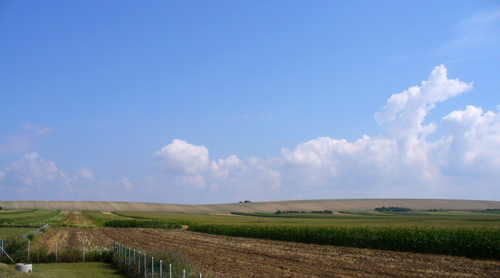 After spending the night aboard ship as we cruised toward Budapest, we docked briefly to board a bus for the ride to Novi Sad (New Garden.) It was a beautiful ride through the countryside with fields of corn and wheat, as well as sunflowers and sugar beets.
After spending the night aboard ship as we cruised toward Budapest, we docked briefly to board a bus for the ride to Novi Sad (New Garden.) It was a beautiful ride through the countryside with fields of corn and wheat, as well as sunflowers and sugar beets.
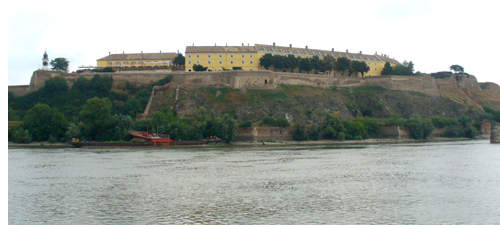 Our first stop was for this view of the Petrovaradin Fortress on the Danube River, across from Novi Sad. It began as a Roman fortress with additions made through the medieval period. It was enlarged and further fortified by the Austrians after their successful defeat of the Turkish army in 1692.
The fortress has four levels and about 10 miles of underground corridors.
Our first stop was for this view of the Petrovaradin Fortress on the Danube River, across from Novi Sad. It began as a Roman fortress with additions made through the medieval period. It was enlarged and further fortified by the Austrians after their successful defeat of the Turkish army in 1692.
The fortress has four levels and about 10 miles of underground corridors.
Petrovaradin fortress has been an important cultural and art center since 1951, and a large art colony with over 88 art studios.
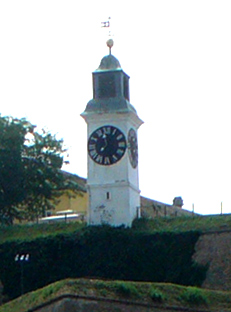 An oddity of the clock tower at the Petrovaradin Fortress is that the big hand tells the hours while the small hand tells the minutes. This was done so the citizens of Novi Sad and the shippers traveling along on the Danube could see the time from a long distance. At the time of this photo it was about 11:40.
An oddity of the clock tower at the Petrovaradin Fortress is that the big hand tells the hours while the small hand tells the minutes. This was done so the citizens of Novi Sad and the shippers traveling along on the Danube could see the time from a long distance. At the time of this photo it was about 11:40.
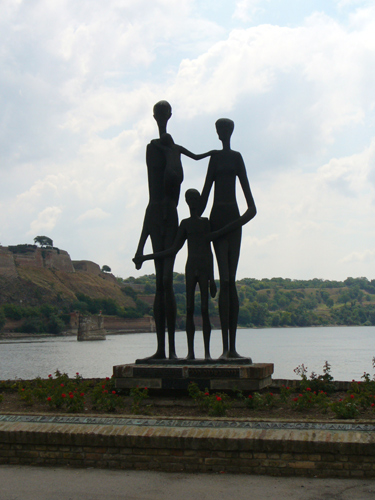 On this side of the Danube is "The Family", an impressive memorial commemorating the death of 1400 people in an attack in 1942.
On this side of the Danube is "The Family", an impressive memorial commemorating the death of 1400 people in an attack in 1942.
 A view of the city of Novi Sad from the fortress side of the Danube.
A view of the city of Novi Sad from the fortress side of the Danube.
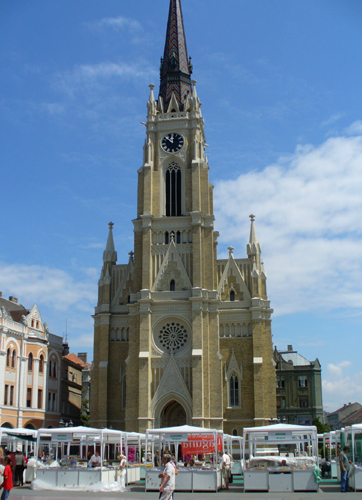 The neo-Gothic Cathedral of the Name of Mary Church is a Roman Catholic church in the main square of Old Novi Sad. Locals refer to it as the "Catholic Cathedral" even though the actual cathedral (with seat of the Bishop) is located in Subotica.
The neo-Gothic Cathedral of the Name of Mary Church is a Roman Catholic church in the main square of Old Novi Sad. Locals refer to it as the "Catholic Cathedral" even though the actual cathedral (with seat of the Bishop) is located in Subotica.
The church was built on the foundation of an old Roman Catholic church, which was damaged during Revolution of 1848. This church was not restored correctly, so Catholics from Novi Sad decided to build a new church. It was finished in the end of the 19th century, in 1894 by György Molnár. The church is a three-nave building, with gothic arches. The roof tiles were made of Zsolnay ceramics. It is the highest church in region and dominates the city center of Novi Sad.
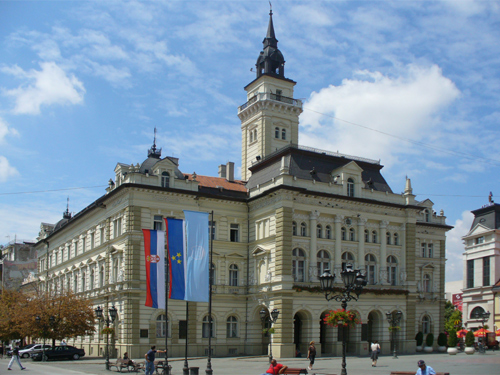 At the opposite end of the square is the City Hall.
At the opposite end of the square is the City Hall.
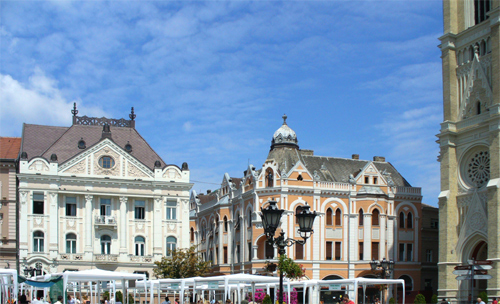 Along a third side are these mansions. The one on the right is called the Iron Man mansion since it has a suit of armor incorporated into its facade, on the left corner.
Along a third side are these mansions. The one on the right is called the Iron Man mansion since it has a suit of armor incorporated into its facade, on the left corner.

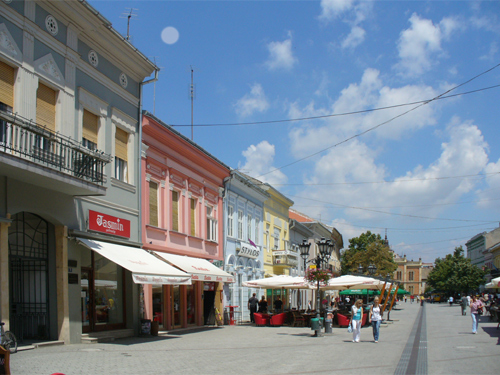 A pedestrian street with beautifully colored buildings led from the main square.
A pedestrian street with beautifully colored buildings led from the main square.
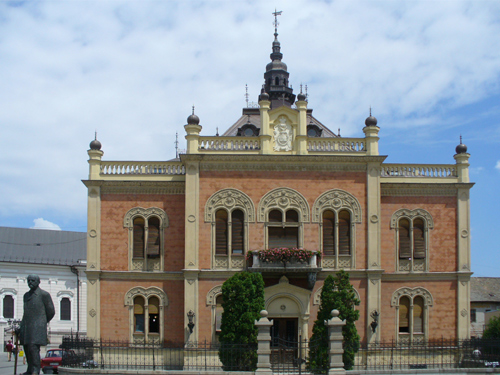 At the end of this street was the Bishop's Palace of the Orthodox Church.
At the end of this street was the Bishop's Palace of the Orthodox Church.
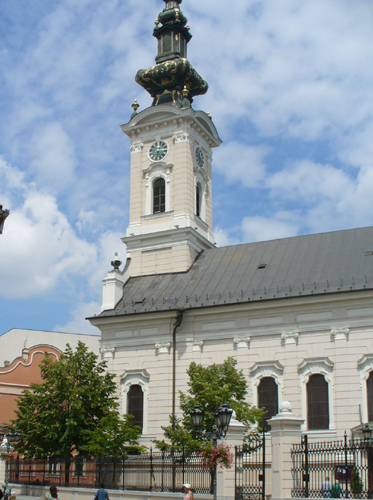 Behind the Bishop's Palace was the Serbian Orthodox Church of St. George, originally built in 1734 and extensively renovated in 1902.
Behind the Bishop's Palace was the Serbian Orthodox Church of St. George, originally built in 1734 and extensively renovated in 1902.
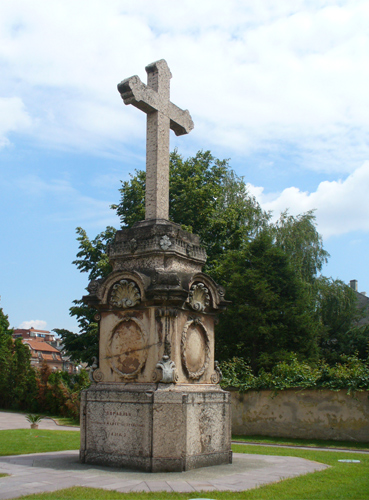 In its courtyard is Novi Sad's oldest monument, a red marble Orthodox cross, probably dating back to the first half of the 18th century.
In its courtyard is Novi Sad's oldest monument, a red marble Orthodox cross, probably dating back to the first half of the 18th century.
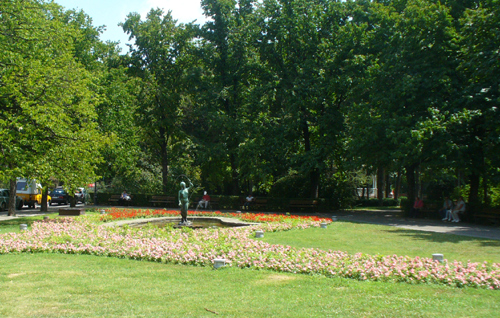 Near the square was a garden.
Near the square was a garden.
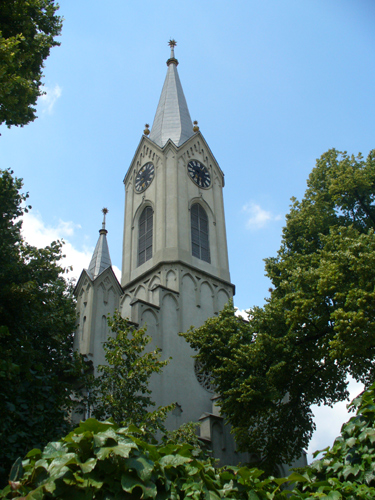 After having seen a Catholic church and an Orthodox church, we had to find the Reformed church in Novi Sad. We found it, but it was closed for renovation.
After having seen a Catholic church and an Orthodox church, we had to find the Reformed church in Novi Sad. We found it, but it was closed for renovation.
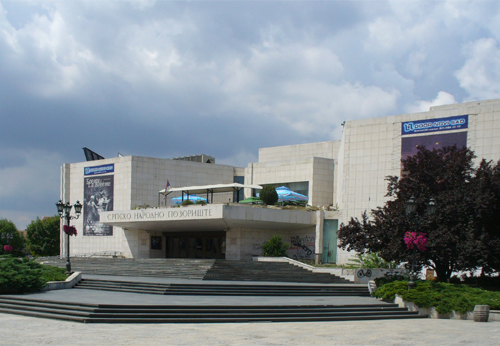 The Serbian National Theatre is the oldest Serbian professional theatre. It is based in Novi Sad, the second largest city of Serbia. The theatre was founded in 1861 and the building which the theatre currently occupies was opened in March 1981.
The Serbian National Theatre is the oldest Serbian professional theatre. It is based in Novi Sad, the second largest city of Serbia. The theatre was founded in 1861 and the building which the theatre currently occupies was opened in March 1981.
After a day in Novi Sad, we returned to the ship and prepared for tomorrow's cruise to Budapest, stopping first at Vukovar in Croatia.
